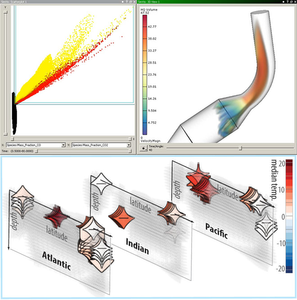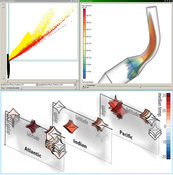Information
- Publication Type: WorkshopTalk
- Workgroup(s)/Project(s):
- Date: October 2013
- Event: IEEE VisWeek
- Lecturer:
- Steffen Oeltze
- Helwig Hauser
- Johannes Kehrer
- Location: Atlanta, Georgia, USA
Abstract
In a growing number of application areas, a subject or phenomenon is investigated by means of multiple datasets being acquired over time (spatiotemporal), comprising several attributes per data point (multi-variate), stemming from different data sources (multi-modal) or multiple simulation runs (multi-run/ensemble). Interactive visual analysis (IVA) comprises concepts and techniques for a user-guided knowledge discovery in such complex data. Through a tight feedback loop of computation, visualization and user interaction, it provides new insight into the data and serves as a vehicle for hypotheses generation or validation. It is often implemented via a multiple coordinated view framework where each view is equipped with interactive drill-down operations for focusing on data features. Two classes of views are integrated: physical views, such as direct volume rendering, show information in the context of the spatiotemporal observation space while attribute views, such as scatter plots and parallel coordinates, show relationships between multiple data attributes. The user may drill-down the data by selecting interesting regions of the observation space or attribute ranges leading to a consistent highlighting of this selection in all other views (brushing-and-linking). Three patterns of explorative/analytical procedures may be accomplished by doing so. In a feature localization, the user searches for places in the 3D/4D observation space where certain attribute values are present. In a multi-variate analysis, relations between data attributes are investigated, e.g., by searching for correla- tions. In a local investigation, the user inspects the values of selected attributes with respect to certain spatiotemporal subsets of the observation space.In this tutorial, we discuss examples for successful applications of IVA to scientific data from various fields: climate research, medicine, epidemiology, and flow simulation / computation, in particular for automotive engineering. We base our discussions on a theoretical foundation of IVA which helps the tutorial attendees in transferring the subject matter to their own data and application area. In the course of the tutorial, the attendees will become acquainted with techniques from statistics and knowledge discovery, which proved to be particularly useful for a specific IVA application. The tutorial further comprises an overview of off-the-shelf IVA solutions, which may be be particularly interesting for visualization practitioners. It is concluded by a summary of the gained knowledge and a discussion of open problems in IVA of scientific data.
The tutorial slides will be available at: http://tinyurl.com/SciDataIVA13
Additional Files and Images
Weblinks
No further information available.BibTeX
@WorkshopTalk{oeltze-2013-tut,
title = "IEEE VIS Tutorial on Interactive Visual Analysis of
Scientific Data",
author = "Steffen Oeltze and Helwig Hauser and Johannes Kehrer",
year = "2013",
abstract = "In a growing number of application areas, a subject or
phenomenon is investigated by means of multiple datasets
being acquired over time (spatiotemporal), comprising
several attributes per data point (multi-variate), stemming
from different data sources (multi-modal) or multiple
simulation runs (multi-run/ensemble). Interactive visual
analysis (IVA) comprises concepts and techniques for a
user-guided knowledge discovery in such complex data.
Through a tight feedback loop of computation, visualization
and user interaction, it provides new insight into the data
and serves as a vehicle for hypotheses generation or
validation. It is often implemented via a multiple
coordinated view framework where each view is equipped with
interactive drill-down operations for focusing on data
features. Two classes of views are integrated: physical
views, such as direct volume rendering, show information in
the context of the spatiotemporal observation space while
attribute views, such as scatter plots and parallel
coordinates, show relationships between multiple data
attributes. The user may drill-down the data by selecting
interesting regions of the observation space or attribute
ranges leading to a consistent highlighting of this
selection in all other views (brushing-and-linking). Three
patterns of explorative/analytical procedures may be
accomplished by doing so. In a feature localization, the
user searches for places in the 3D/4D observation space
where certain attribute values are present. In a
multi-variate analysis, relations between data attributes
are investigated, e.g., by searching for correla- tions. In
a local investigation, the user inspects the values of
selected attributes with respect to certain spatiotemporal
subsets of the observation space. In this tutorial, we
discuss examples for successful applications of IVA to
scientific data from various fields: climate research,
medicine, epidemiology, and flow simulation / computation,
in particular for automotive engineering. We base our
discussions on a theoretical foundation of IVA which helps
the tutorial attendees in transferring the subject matter to
their own data and application area. In the course of the
tutorial, the attendees will become acquainted with
techniques from statistics and knowledge discovery, which
proved to be particularly useful for a specific IVA
application. The tutorial further comprises an overview of
off-the-shelf IVA solutions, which may be be particularly
interesting for visualization practitioners. It is concluded
by a summary of the gained knowledge and a discussion of
open problems in IVA of scientific data. The tutorial
slides will be available at: http://tinyurl.com/SciDataIVA13",
month = oct,
event = "IEEE VisWeek",
location = "Atlanta, Georgia, USA",
URL = "https://www.cg.tuwien.ac.at/research/publications/2013/oeltze-2013-tut/",
}


 Tutorial proposal
Tutorial proposal
